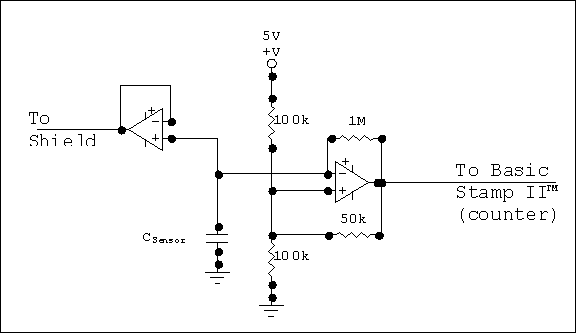

The "Capaciflector" Proximity Sensor
What is the "Capaciflector"?
The Capaciflector was developed at the Goddard Space Center by John Vranish and Lou Palombo. The sensor consists of three plates: the sensing plate, the reflecting shield, and the ground plate. The novel concept for this sensor is the use of the reflecting shield to force the electric field lines outward from the sensor plates. This reflecting shield is driven to always be at the same potential as the sensing plate. In this way the sensing plate can not directly "see" the ground plate:

Figure 1: Capaciflector concept.
The capacitance value will be strongly affected by an object of different dielectric constant entering the electric field lines between the sensing plate and the ground plate.
Electronics:
The easiest way to measure this capacitance is by setting up an oscillator circuit whose frequency of oscillation is inversely proportional to the capacitance. The circuit we are using is called a relaxation oscillator circuit:

Figure 2: Relaxation Oscillator Circuit.
The output from the relaxation oscillator is connected to an input pin on a Basic Stamp IITM microprocessor which counts oscillations for a specified period. This count will be proportional to the frequency of oscillation. This count is output from a serial communication line of the Basic Stamp IITM.
Robotics Applications:
This proximity sensor can be used to prevent a robot from colliding with objects in its environment. It can also be used as a guidance mechanism for gripping objects. It is an attractive sensor because the sensing element itself (the three plates) can be very thin and can be inconspicuously applied to the surface of moving parts of the robot.
The particular application in this case is for the ProVAR project at the Veterans Affairs Rehabilitation Research and Development Center in Palo Alto . This project has implemented a Puma 260 robotic arm as a workstation assistant for individuals who lack the manual dexterity to perform office work (typically due to high level spinal cord injury). With a person working in close proximity with the robotic arm, it is very important to implement extensive safety measures to prevent possible injury. This is the primary motivation for adding proximity sensing capabilities to this system. Human tissue has a dielectric constant very close to that of salt water ( ~80X that of air), and thus the Capaciflector sensor is a good match for this application.
The eventual goal is to implement a network of these sensors, smartly distributed on the Puma arm. This network will communicate with a central microprocessor which serves as a gateway to dual port RAM accessible by the robot controller
Current Work:
A prototype sensor has been built and is currently being tested. The initial goal is to characterize the sensor. This involves determining:
- the frequency vs. distance curve fit (for some standard object)
- how the size and shape of the object affect the reading.
- how changes in environmental temperature and humidity affect the baseline frequency of sensor (sensor drift/hysteresis).
- how sensors in close proximity to each other affect performance (crosstalk).
- Dr. Mark Cutkosky, Dextrous Manipulation Lab, Center for Design Research
- Dr. Machiel Van der Loos, Veterans Affairs Rehabilitation Research and Development
- The Whitaker Foundation
- The Department of Veterans Affairs